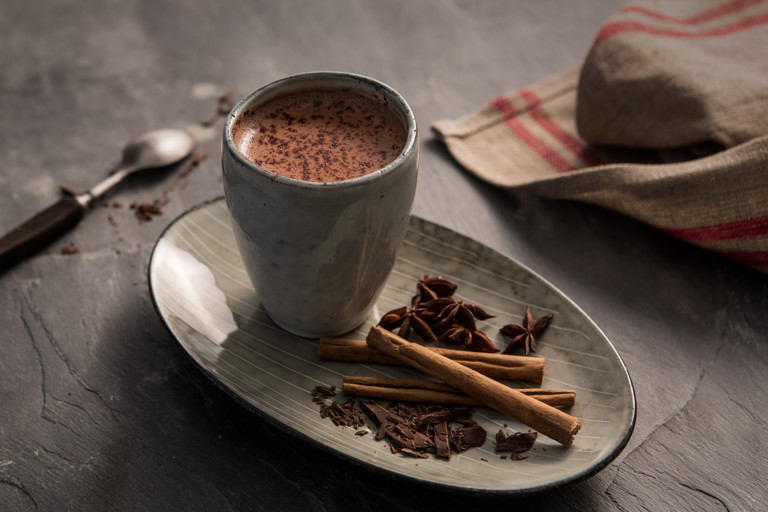Hot chocolate
- Drink
- 1
- 15 minutes
Despite renaissance in coffee quality in recent years most cafés have sadly neglected their hot chocolate offering. Jennifer Earle redresses the balance with her favourite ever hot chocolate recipe, and even includes a healthy hot chocolate recipe for health-conscious chocolate lovers.
"Chocolate is the divine drink which builds up resistance and fights fatigue. A cup of this precious drink permits man to walk for a whole day without food."
So said the man who first brought cocoa back to Europe in 1528. Hernando Cortés was a Spanish explorer who, according to various accounts, was mistaken for the Aztecs’ god Quetzalóatl who had been forecast to arrive in 1519 to free them from having to make sacrifices to ensure the sun would rise each day. Conveniently, this was the year Cortes happened upon them. With the military nickname “Killer” and a precedent for conquering by force, if the Aztecs hadn’t offered him their riches he might well have just taken them. If he had taken them he likely would have focused on the gold and, like Columbus before him, ignored the small brown beans. Perhaps only because of this extended comfortable stay he was able to observe the reason for the Aztec’s obsession with chocolate, leading to the quote above and inspiring him to bring it back to Spain to present to the king. It is likely he was the person who first began adding sugar to the complex mix of cocoa, water, spices, honey and maize as the drink was regarded as quite disgusting to most of the Europeans who tasted it.
The original chocolate drink contained all manner of ingredients, all included for some sort of perceived medicinal, life-giving or sacrificial purposes. A cocoa-based liquid was often used to represent blood in sacrificial rites and achiote (better known as annatto in Europe now, and used as a natural food colouring) was added to make it look redder. Achiote in these kind of quantities would have definitely made the drink more bitter, making one of the proposals for the word chocolate – from “xocolāl” meaning “bitter water” – all the more plausible.
Chocolate was initially drunk cold, appropriate for the hot climate where cocoa grows – and Cortés went on to establish cocoa plantations in several places in Central America and the Caribbean to provide for the growing appetite of the Spanish elite. As well as adding sugar, the Spanish also started to serve the drink hot. They were less likely to include chilli and maize and often included almonds. By the time the drink reached England in the mid-17th Century, chocolate houses were adding rose water and ambergris, as well as spices, to flavour their blends.
It was the UK’s own Sir Hans Sloane, best known for the swathes of land in and around Chelsea that he purchased, who first promoted using cow’s milk in chocolate drinks. Sloane was a physician who had observed the positive effect “prescriptions” of cocoa from local Jamaican doctors had on all manner of ailments when he was working on the island. When Sloane returned to London he proposed that it could only be healthier mixed with calcium-rich, fresh cow’s milk as well. It was still over a hundred years before milk in chocolate drinks became as common as it now, mainly due to people’s lack of access to either cocoa beans or fresh milk.
By 1900 when the taxes on chocolate and sugar had decreased enough to make chocolate affordable to the masses it was usually just cocoa powder, sugar and milk that made the nation’s beloved chocolate drink and Cadbury’s had finally pipped Fry’s as the largest producer of cocoa, with Rowntree’s following behind.
Despite renaissance in coffee quality in recent years most cafés have sadly neglected their hot chocolate offering. I won’t touch hot chocolate in most cafés because I know I’ll likely be served some weak, powdery hot milk with barely a hint of cocoa. Fortunately there are a few stand-out places where I know that’s not the case, or to be safe, I just make one at home:
If making the healthier version, you could also add prunes to this if you have a blender and like it sweeter. Other dried fruit can cause it to congeal which isn’t pretty or delicious!
Ingredients
Metric
Imperial
Hot chocolate
- 300ml of whole milk
- 40g of dark chocolate, the best quality you can find
- 2 tsp boiling water
- 1 pinch of sea salt, tiny (not table salt)
Optional extras
- 1 tbsp of cream
- 3 drops of vanilla extract
- 1 pinch of sugar, more or less depending on the sweetness of the chocolate used (if you add vanilla and cream you really shouldn’t need sugar as well!)
- 1 tbsp of rum
For a healthier version
- 120ml of almond milk, (buy in most supermarkets or make your own with a blender, water and a muslin cloth to strain the liquid through – or leave the bits in!)
- 15g of dark chocolate, 100% (Willie’s Cacao is widely available in most supermarkets or failing this you could use cocoa instead, but it won’t be as rich and delicious)
- 1 pinch of pink Himalayan salt, (contains 82 essential minerals)
- 1 tsp Manuka honey, (good for its antibacterial properties)
- 180ml of boiling water
- 3 drops of vanilla extract, optional (makes it taste sweeter without adding more sugar)
- 1 pinch of cinnamon, (good for the metabolism and, again, making it taste sweeter without calories)
Method
Get in touch
Please sign in or register to send a comment to Great British Chefs.


